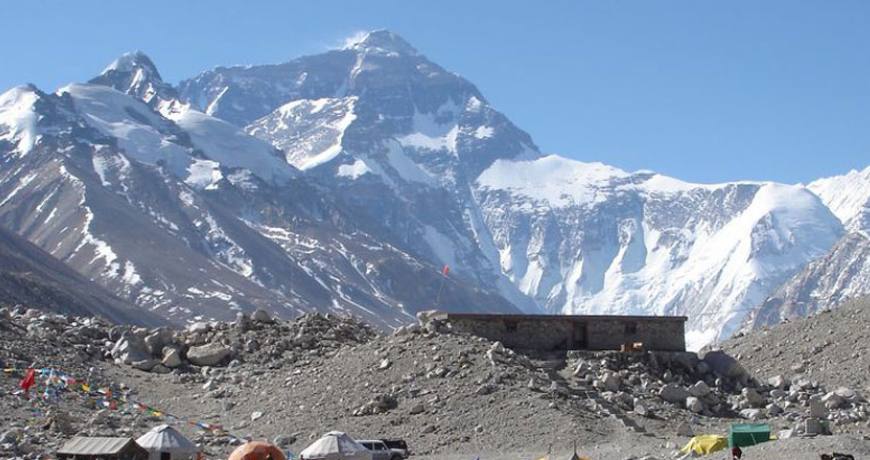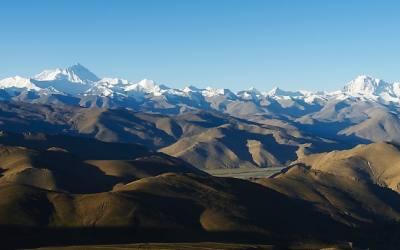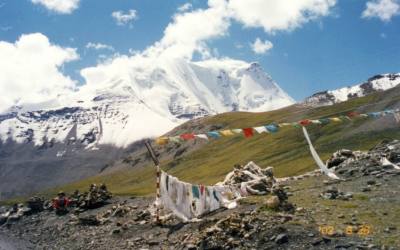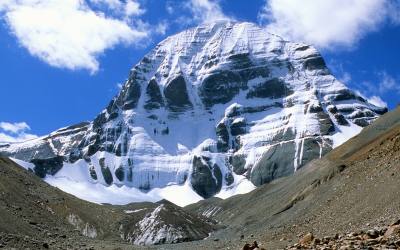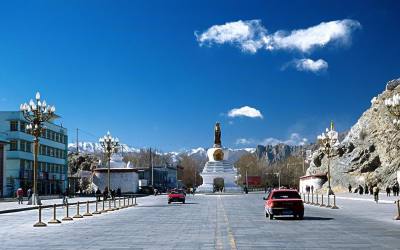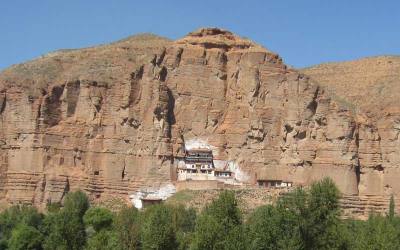For thousands of years, Tibet lay under the ancient Sea of Tethys. Eighty million years ago, India crashed into Asia, pushing up the Himalayas, lifting the ocean bottom above water, and creating this magical land. Mystical land, Shangrila, Forbidden Country: Tibet has many names and inspires an air of mystical dreams. However, Tibet is real and a beautiful place to travel. It possesses a unique culture, firmly rooted in Tibetan religion, but with strong influence from the geography of the Himalayas, and the neighbouring civilisations of India and China.
Geographically, Tibet can be divided into three major parts - north, south and east. The eastern part is forest region, occupying approximately one-fourth of the land. Virgin forests run the entire breadth and length of this part of Tibet. The northern part is open grassland, where nomads and yak and sheep dwell here. This part occupies approximately half of Tibet. The southern and central part is agricultural region, occupying about one-fourth of Tibet’s land area. All major Tibetan cities and towns such as Lhasa, Shigatse, Gyantse and Tsetang are located in this area and is considered the cultural center of Tibet.
Day 01: Kathmandu to Lhasa by air
Day 02: Lhasa sight seeing tour
Day 03: Lhasa sight seeing tour
Day 04: Gyantse
Day 05: Shigatse
Day 06: Shegar
Day07: Shegar ( Everest base camp Excursion)
Day08: Nyalam or Zhangmu
Day09: Zhangmu to Kathmandu
For competitive quotation please call us or mail us
Day 1 - Lhasa
We are transferred from our hotel to Kathmandu Airport for our flight to Tibet. This is one of the most spectacular flights in the world as we follow the high mountain peaks before crossing over the Himalayan chain to the high Tibetan Plateau. On arrival at Gongkar Airport we are met and driven by coach to the fabled city of Lhasa, which lies at 3650 metres above sea level.
Day 2-3 - Lhasa
In Lhasa we have two days to explore this once-isolated city, with its monasteries and markets bulging with pilgrims and traders. This includes an organised tour to the Potala Palace, Jokhang Temple, and Sera and Drepung Monasteries. Free time to explore the city is subject to the Chinese authorities and the ever-changing ’political climate’, although there are never any problems with filling in the days to great advantage in such a fascinating city. In your free time you may wish to visit the Norbulingka Summer Palace or the interesting Tibet Museum.
Day 4 - Gyantse
Today we travel for about seven hours as we take to the Friendship Highway; a spectacular road, which traverses high mountain passes and crosses plateaus, connecting Lhasa with Kathmandu. Please note that the road conditions are very poor in Tibet, so we should be prepared for bumpy journeys. We first travel through Tibet’s richest farming areas, then cross the Brahmaputra River as it winds its way down to the Bay of Bengal. Running here at an altitude of 3939 metres above sea level, it is the highest major river in the world. We cross the river on a solid suspension bridge and wind our way to Kamba-la and enjoy a view over the huge Yamdrok Tso Lake. After the lake, we climb again to Karo-la (5010 metres) before descending to the historic town of Gyantse, a small village and home to the Kumbum Monastery, where we find interesting Buddhist murals.
Day 5 Shigatse
In the morning we explore Gyantse, a town renowned for the exploits of Colonel Younghusband in the 1920s. We walk down the newly rebuilt main street to the Nepali Kumbum Stupa. In the afternoon we take a three-hour drive across the Tibetan Plateau. Shigatse is the second largest city in Tibet with a population of some 40,000 people. The Tashilhunpo Monastery is the traditional seat of the Panchen Lama, the most important incarnation for Tibetan Buddhists, after the Dalai Lama. This impressive religious centre contains a giant statue of Buddha in the Temple of Maitreya, as well as an ornate tomb which is the final resting-place of the fourth Panchen Lama. Its huge size ensures it is almost a town in itself. One of Tibet’s most active monasteries, it is currently being restored to its former beauty.
Day 6 - Shegar
Our adventure continues with an eight-hour drive over rough, dusty roads to Shegar. In the morning we cross the Gyatso-la with stunning views of the Himalayan peaks to the south. Although the scenery is desolate, the country is dotted with busy villages and ruined monasteries. Amongst these villages is the major town of Lhaze, which makes a convenient halfway stop where we have a local-style lunch break. Shegar is a small village of 1,500 inhabitants with an interesting fort.
Day 7 - Shegar (Everest Base Camp Excursion)
We leave early in the morning from the hotel, branching off onto a small road that leads to Everest Base Camp. The day will be quite long (approximately six to seven hours driving), but extremely rewarding. The initial part of the journey involves climbs in a series of zigzags to the top of the Pang-la Pass (5150 metres), where we stop to take photos of Mount Everest before descending to the Rongphu Valley. We continue to the famous Rongphu Monastery and then on to the Base Camp itself, situated at 5040 metres above sea level. The views of Everest from here are sensational with the towering North Face dominating the horizon. This is certainly a major highlight on our incredible journey. We retrace our steps back to the relative comfort of our hotel in Shegar.
Day 8 - Zhangmu
Today we travel for 225 kilometres, taking between seven to eight hours. From the hotel we pass through a check-post and continue to Tingri, where we enjoy more views of the world’s highest peaks, including the 8000-metre giants: Everest and Cho Oyu. From Tingri the road ascends to reach the Lalung-la (5050 metres), where the scenery is again fantastic. The panorama also includes the 8000-metre-high Xixapangma. From the top of the pass we descend nearly 3000 metres to the small town of Nyalam, before continuing to the border town of Zhangmu. As you near the border, the road is cut into the cliffs high above the valley floor. If you don’t like heights, sit on the left-hand side of the vehicle! At Zhangmu you say farewell to your Tibetan guide and driver.
Day 9 - Kathmandu
Today, after finalising departure formalities, you exit from China and enter Nepal. Descending steeply down the zigzag road, you reach the Nepalese immigration and customs at Tatopani. During the monsoon season there may be landslides, which may cause sections of the road near the border to be closed. Should this be the case, porters then carry our luggage as we walk across the border to our Nepalese vehicle. It is then a 4½-hour drive back to Kathmandu, where we return to our hotel.
Day 10: Tour Ends ( Departure onwards)
Trip Attractions
Rongpu Monastery
Shuo Atop the Rongpu Qinzhogma Hill at the foot of Mt. Qomolangma, Rongpu monastery is 90 kilometers away from the Tingri County seat and is 5,800 meters above sea level? It is the highest monastery in the world, so the scenery is as great as you can imagine.
Rongpu Monastery was originally constructed by Red Sect Lamas in1899, although it is not as old as other monasteries in Tibet, it is famous for its high latitude and murals.
The monastery has five stories, but only two of them are being used now. It is said that the reason why they built the monastery so high was that they want to enjoy a quiet environment and have a sound sleep.500 hundred monks lived here once while the monastery was very popular, but only 50 monks and nuns live here nowadays.
Annually it holds three-day sorcerers activities on the 15th of the fourth month and the Ghost-Beating Festival on the 29th of the 11th month of the Tibetan calendar.
It is 60 kilometers from New Tingri to the Rongpu Monasterry. Tourists can take a taxi to go to the monastery because there is no regular bus. The monastery provides lodging places for $4 each bed.
Palkhor Monastery
The Palkhor Monastery lies about 230 kilometers south of Lhasa in Southwest China’s Tibet Autonomous Region and 100 kilometers east of the Shigatse Prefecture, at the foot of Dzong Hill.
It is well-known for its Kumbum, which has 108 chapels in its four floors. The multi-storied Kumbum Stupa was crowned with a golden dome and umbrella, surrounded with more chapels filled with unique religious statues and murals.
The monastery was founded in 1418 by the second Prince of Gyantse, Rabten Kunsang, who was a devotee of Kedrub Je, Tsongkapa’s disciple. It became an important centre of the Sakya sect of Tibetan Buddhism.
In 1904, the town and monastery were attacked by British soldiers, most of the damages were later restored, but bullet holes from this attack remain there up to now.
It was partially destroyed in 1959 after a revolt against Chinese ruling class and again was damaged in the Cultural Revolution (1966-1976), but has since been largely restored.
The compound housed approximately 15 different monasteries, made up of three different sects (Gelugpa, Sakyapa, and Kahdampa) in a rare instance of tolerance amongst the Tibetan sects of Buddhism. It is the only monastery that housed monks from different sects in harmony. Meanwhile, its structural style, enshrined deities, and murals are pretty special.
Palkhor Monastery is most famous for its Bodhi stupa (Kumbum in Tibetan, meaning hall of 10,000 Buddhist figures).
As the symbol of the monastery, the spectacular stupa (Buddhist shrine) consists of hundreds of chapels in layers, housing a hundred thousand figures of Buddha or so, Bodhisattvas, Vajras (thunderbolt symbols), Dharma Kings, Arhats (enlightened Buddhists), and disciples and great experts of different orders in Tibetan Buddhist history. The stupa also contains about 3,000 statues of outstanding figures in Tibetan history such as Songtsen Gampo and Trisong Detsen, so it is also called Myriad Buddha Stupa.
Covering a space of 2,200 square meters, the stupa has a total 108 gates and 77 chapels, each of which has a dominant religious figure and murals. The cylinder, 20 meters in diameter, has four chapels inside. The elegant structure is worth a visit.
Drepung Monastery
Situated at the foot of the Mountain Gambo Utse, 5 kilometers (3.1 miles) from the western suburb of Lhasa, the Drepung Monastery is known as the most important monastery of Gelugpa in Tibetan Buddhism. It is considered one of the ’Three Great Monasteries’ (the other two are the Ganden Monastery and the Sera Monastery. Covering an area of 250,000 square meters (299,007 square yards), it held 7,700 monks in total and possessed 141 fazendas and 540 pastures in its heyday, and is the largest-scale monastery among the ones of the same kind. Seen from afar, its grand, white construction gives the monastery the appearance of a heap of rice. As such, it was given the name ’Drepung Monastery’ which, in the Tibetan language, means Monastery of Collecting-Rice.
History
The monestary was established in 1416 by Tsong Khapa’s disciple Jamyang Qoigyi, who was versed in both Esoteric and Exotoric Buddhism and became the first Kampo there. With the support of plutocrats, it developed as the richest monastery of Gelugpa and became the mother temple of Dalai Lamas. In 1546, the third Dalai was welcomed as the first Living Buddha into the monastery. At the invitation of Mongolia’s king, he went to Qinghai Province to preach. He was dignified with the title ’the third Dalai Lama’ the first and second Dalai were entitled, too. It is the very place that the second, third, and the fourth Dalai Lama held the Sitting-in-Bed Ceremony, as well as the residence of the fifth Dalai before his nomination by the government of the Qing Dynasty (1644 - 1911).
Systems
The organizational hierarchy of the monastery is rather complex. The main branches of the organization consist of Coqen, Zhacang, Kamcun, and Myicun. Coqen is in the highest position, to which Zhacang belongs, and Kamcun is under the jurisdiction of Zhacang, with the Myicun as its subordinate. Monks belonging to respective Zhacangs cannot interblend with each other.
The education system in Zhacangs is set up such that, every year there are eight chances to study the sutra collectively, each time spanning from half a month to a month. Monks are tested before the Kampo in the method of reciting sutras and debating, and based on their performance; receive the degrees of different levels.
Visit to the Monastery
The ground of the monastery is organized on the caves and temples for Jamyang Qoigyi, together with two magnificent white pagodas. The buildings of the monastery are centered on these pagodas, The major buildings are Ganden Potrang, Coqen Hall, the four Zhacangs (or Tantric colleges), and Kamcuns.
The Ganden Potrang, in the southwest corner of the monastery, was built under the supervision of the second Dalai Lama Gendun Gyaco around the year of 1530. It became the residence of the second, third, fourth, and the fifth Dalai Lamas. After the fifth Dalai Lama moved to the Potala Palace, it was served as the meeting place for the local regime for both politics and religion.
The Coqen Hall is located in the center of the monastery. In front of it, is a square occupying an area of about 1,850 square meters (2213 square yards). Stepping on the wide stone stairs, you will see the grand Entrance Hall. Inside is the Sutra Hall supported by 183 pillars, and spanning 1,850 square meters. Amongst the colorful decorations, there are fine and vivid statues of Buddha. The second story houses collections of precious sutras. There are a set of Gangyur Tripitaka written in gold powder, and woodcarving sutras of the Qing Dynasty. On the third story is enshrined a huge bronze statues of Qamba Buddha, which is said to be the future appearance of the Qamba Buddha in his 8th year. It is worshiped by the disciples of Buddhism.
The monastery is composed of 4 Zhacangs, functioning as the sutra-learning places and the subordinate organization. Loseling Zhacang is the largest with the most lamas. The Loseling, Gomang, and Deyang Zhacang focus on the Esoteric Buddhism, while the Ngaba Zhacang on the Exotoric Buddhism.
Several courtyards in the dense forests on the grounds of the monastery are used for monks to debate on the sutras. The courtyards sites are always chosen near Zhacang and various trees are grown. After enduring the debating period in both Zhacang and the entire monastery, the winner will obtain the qualification to attend the test for the senior degree of Geshi.
Cultural Relics
The Drepung Monastery houses many cultural relics, which adorn the monastery and make it more superb. Statues of Manjushri Bodhisattva, and Sitatapatra found on the first storey of the Coqen Hall, rare sutras on the second storey and Jamyang Qoigyi’s conch shell given by Tsong Khapa on the third one, all add to the wonderment of the monastery. Exquisite statues of Tsong Khapa, Kwan-yin Bodhisattva, Manjushri Bodhisattva, Amitayus, and Jamyang Qoigyi in other sutra halls, as well as flowery murals on walls also fully present the wisdom of the Tibetan people.
Mt. Everest
Mt. Everest, also called Mount Qomolangma , is the highest peak in the world. Its Tibetan meaning of ’Goddess the Third’ adds more mysterious color and magic power to the subject. As a result, it has intrigued all kinds of people since it was first discovered. Pilgrims trek long distances to present a pious worship, climbing enthusiasts run great risks to challenge its high altitude and the common tourists also yearn for a reverent look at this holy peak.
The altitude of Mt. Everest is now about 8,844.43 m. (29,017 ft.). It is the dominant peak of Himalayas, the northern brae in Tingri County of Tibet and the southern in the Nepal. The area has 4 peaks above 8,000 m. (26,247 ft.) and 38 peaks above 7,000 m. (22,965 ft.), hence the laudatory title ’the Third Pole of the Earth’.
As the supreme point of the world, Mt. Everest is also blessed with many extreme wonders. The top part of the mountain is covered with snow all the year
What’s Included
- Airport drop by private transport
- Air ticket from Kathmandu to Lhasa
- Tibetan English speaking guide
- Tibet travel permit
- Transportation in lhasa by private land crusher or by private mini van
- Accommodation on twin sharing basis with breakfast at budget class hotel
- All the entrance fees for monastery as per itinerary at Tibet
What’s not Included
- Sight seeing tour in kathmandu valley and all the entrance fees
- Lunch & dinner
- Personal expenses like tips drinks etc
- Reentry visa fee for Nepal
